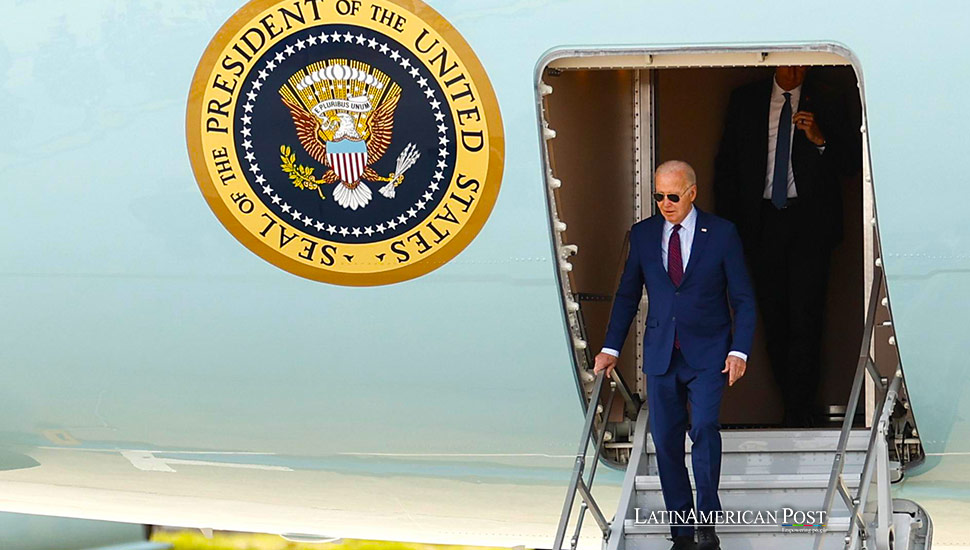Biden’s New US-Mexico Border Asylum Ban Faces Challenges

U.S. President Joe Biden’s recent asylum ban, a significant move ahead of November’s elections, raises questions and faces criticisms, emphasizing the complexities of immigration policy.
In a sweeping enforcement action ahead of the upcoming November elections, U.S. President Joe Biden has instituted a broad asylum ban on migrants caught illegally crossing the U.S.-Mexico border. This measure marks a critical point in Biden’s presidency as immigration continues to be a pivotal issue influencing voter sentiment. The ban, set to take effect just after midnight, allows for the rapid deportation or return to Mexico of migrants crossing illegally, with exceptions for unaccompanied children, individuals facing severe medical or safety threats, and victims of trafficking, according to the U.S. Department of Homeland Security.
As Biden prepares for a fierce electoral battle against Republican candidate Donald Trump, the asylum ban highlights a significant shift in his administration’s approach to border security. Initially, Biden promised to reverse many of Trump’s restrictive immigration policies. However, record levels of illegal crossings have pressured U.S. border authorities and strained resources in cities receiving new arrivals. This latest move underscores Biden’s response to growing public concern over immigration control and his attempt to balance enforcement with humanitarian considerations.
During a White House press conference, Biden emphasized that asylum access would still be available to migrants who register for appointments using the CBP One app or other legal pathways instead of crossing illegally. “This action will help us gain control of our border and restore order into the process,” Biden stated. “This ban will remain in place until the number of people trying to enter illegally is reduced to a level our system can effectively manage.”
Reactions and Criticisms
Biden’s decision has drawn criticism from both sides of the political spectrum. Immigration advocacy groups, such as the American Civil Liberties Union, have vowed to challenge the ban in court, accusing Biden of adopting Trump-like policies and reneging on U.S. legal obligations to asylum seekers. On the other hand, Republicans argue that the measure is insufficient and politically motivated, aiming to bolster Biden’s stance on immigration ahead of the elections.
Lee Gelernt, an attorney for the ACLU, stated their intention to sue over the new restrictions. Meanwhile, Trump’s campaign criticized Biden for high levels of illegal immigration and claimed that exempting unaccompanied minors would encourage child trafficking.
The new asylum ban becomes active when the daily average of border arrests exceeds 2,500 over a week, a threshold currently surpassed, with U.S. border arrests averaging 4,300 per day in April. The ban will pause when arrests drop below an average of 1,500 per day for three weeks, a level last seen during the early months of the COVID-19 pandemic in July 2020.
Key questions about the implementation of the measure remain unresolved, including how the administration plans to deport migrants from distant and uncooperative countries quickly and how many non-Mexican migrants Mexico will accept under the new regime.
The new restrictions resemble policies implemented by Trump, using a legal statute known as 212(f), which served as the basis for Trump’s travel bans affecting several majority-Muslim nations and other countries. Biden’s move underscores the enduring complexities and political sensitivities surrounding U.S. immigration policy.
Immigration in Latin America
Latin America has a long migration history, influenced by political instability, economic disparities, and violence. Countries like Mexico, El Salvador, and Honduras have seen significant numbers of citizens migrate northward for better opportunities and safety. The impact of U.S. immigration policies reverberates throughout the region, influencing domestic politics and international relations.
The upcoming presidential election in Mexico has added another layer of complexity to the immigration issue. Claudia Sheinbaum, recently elected Mexico’s first female president in a landslide victory, will take office on October 1. Biden’s border restrictions could put additional pressure on Sheinbaum to manage and reduce illegal border crossings, continuing the cooperative relationship established by her predecessor, Andrés Manuel López Obrador.
Biden’s administration has pushed for greater cooperation with Mexico and other Latin American countries to address the root causes of migration, including poverty, violence, and corruption. During a phone call on Tuesday, Biden thanked López Obrador for his continued cooperation on immigration. López Obrador, in his daily press conference, acknowledged the progress made by both countries on the issue.
Efforts to pass comprehensive immigration reform have faced significant hurdles in Congress. Biden has pushed for a Senate bill crafted by a bipartisan group to toughen border security, but Republicans rejected it after Trump opposed the measure. In addition to the asylum ban, Biden’s administration has taken steps to tighten the asylum process, including issuing a regulation in May 2023 that heightened the standard for initial asylum claims.
Public Opinion and Political Implications
Public opinion on immigration remains deeply divided. A Reuters/Ipsos poll conducted in mid-May shows that registered voters prefer Trump over Biden on immigration policy by a 17 percentage point margin. This significant gap underscores Biden’s challenge in convincing the public of his approach to border security while maintaining his commitment to humanitarian principles.
The implementation of the asylum ban and the political debate surrounding it highlight the broader implications for U.S. immigration policy and its impact on Latin America. The region has long been intertwined with the United States through migration, trade, and cultural exchange. Policies enacted in Washington have far-reaching consequences, affecting the lives of millions across the Americas.
The Path Forward
As the Biden administration navigates these complex issues, the focus remains on finding a balance between effective border enforcement and upholding the United States’s long-standing commitment to providing refuge for those fleeing persecution. The challenges are multifaceted and involve legal, humanitarian, and diplomatic dimensions.
Also read: Sheinbaum Extends Poll Lead in Mexican Presidential Race
Biden’s asylum ban represents a critical juncture in U.S. immigration policy, reflecting the ongoing struggle to address illegal border crossings while maintaining humanitarian values. The decision has sparked controversy and debate, highlighting the complexities of immigration in the modern era. As Latin America grapples with its migration challenges, cooperation, and comprehensive solutions will be essential in addressing the root causes and ensuring a humane and effective response to migration.




